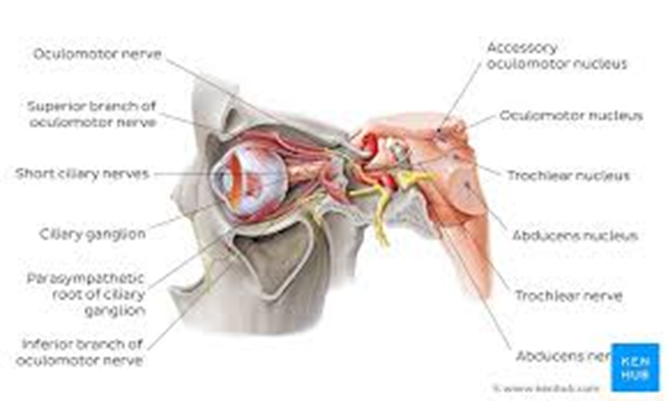The nurse read the patient's health history and noted cranial nerve III oculomotor paralysis. Which of the following would the nurse expect?

The eye cannot look to the outside.
Myopia.
Ptosis will be evident and no pupillary constriction.
Normal eye movement.
The Correct Answer is C
Choice a reason:
The inability of the eye to look outward, known as lateral rectus palsy, is associated with cranial nerve VI, the abducens nerve, not the oculomotor nerve. The oculomotor nerve does not control the lateral rectus muscle which governs this movement.
Choice b reason:
Myopia, or nearsightedness, is a refractive error of the eye where distant objects appear blurry while close objects can be seen clearly. It is not related to oculomotor nerve paralysis, which affects eye movements and pupil response, not the shape of the eyeball or the refractive properties of the lens.
Choice c reason:
Ptosis, or drooping of the upper eyelid, and an absence of pupillary constriction are classic signs of oculomotor nerve paralysis. The oculomotor nerve controls most of the eye's movements, including lifting the eyelid via the levator palpebrae superioris muscle and constricting the pupil through the circular muscles of the iris.
Choice d reason:
Normal eye movement would not be expected in a patient with oculomotor nerve paralysis. This nerve controls the majority of the eye's movements, so paralysis would lead to abnormal eye movement, such as the inability to move the eye upward, downward, or inward.
Nursing Test Bank
Naxlex Comprehensive Predictor Exams
Related Questions
Correct Answer is B
Explanation
Choice A Reason:
Angular cheilitis is characterized by inflammation of one or both corners of the mouth. It often presents as red, swollen patches in the corners of the mouth and can be associated with fungal or bacterial infection. However, it does not typically cause vesicular eruptions, which are more indicative of viral infections like herpes simplex.
Choice B Reason:
Herpes simplex virus (HSV) is known for causing vesicular eruptions, commonly referred to as cold sores or fever blisters, around the lips and mouth area. These eruptions are fluid-filled blisters that can be painful and are highly indicative of an HSV infection, particularly HSV type 1, which commonly affects the oral region.
Choice C Reason:
Angioedema involves the rapid swelling of the deeper layers of the skin, often seen with hives. While it can affect the lips and surrounding areas, it does not cause vesicular eruptions. Angioedema is more associated with allergic reactions and can be part of anaphylaxis, a severe systemic reaction.
Correct Answer is C
Explanation
Choice a reason:
A firm toothbrush is not recommended for plaque removal as it can damage the gums and tooth enamel. Soft-bristled toothbrushes are preferred because they are effective at removing plaque while being gentle on the gums and enamel.
Choice b reason:
Brushing more than twice per day does not necessarily irritate the gums unless done with improper technique or with a hard-bristled toothbrush. It is important to brush gently with a soft-bristled toothbrush and to use fluoride toothpaste to maintain oral hygiene and prevent gingivitis.
Choice c reason:
Ensuring that dental restorations such as fillings and crowns fit well is crucial in preventing gingivitis. Poorly fitted restorations can trap food particles and bacteria, leading to plaque buildup and gum inflammation. Regular dental check-ups can help ensure that restorations remain intact and do not contribute to gingivitis.
Choice d reason:
Flossing should not be avoided even if there is bleeding at the gumline. Bleeding can be a sign of gingivitis, and flossing can help remove the plaque and bacteria causing the inflammation. If bleeding persists, it is important to consult a dentist.
Whether you are a student looking to ace your exams or a practicing nurse seeking to enhance your expertise , our nursing education contents will empower you with the confidence and competence to make a difference in the lives of patients and become a respected leader in the healthcare field.
Visit Naxlex, invest in your future and unlock endless possibilities with our unparalleled nursing education contents today
Report Wrong Answer on the Current Question
Do you disagree with the answer? If yes, what is your expected answer? Explain.
Kindly be descriptive with the issue you are facing.
